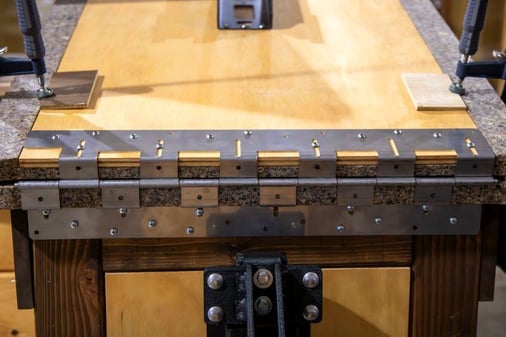
When you’re working through the details of a new product design, it’s easy to think, “A hinge is a hinge.” But if you’ve ever seen a lid sag, a door bind, or an access panel fail under load, you know hinge selection can make or break a design.
The temptation to save a few dollars with a lighter, cheaper hinge is real, especially when budgets are tight. Yet choosing the wrong hinge can lead to damaged equipment, unsafe operation, and costly redesigns down the line.
Let’s look at the real difference between light- and heavy-duty hinges and how to decide which one fits your application best.
Heavy vs. Light-Duty Hinges: What’s the Difference?
At a glance, both hinge types serve the same purpose – enabling smooth, controlled movement between two parts. The difference lies in how much force they can withstand and for how long they can do so reliably.
What Is a Light-Duty Hinge?
Light-duty hinges are built for jobs that don’t demand much muscle. You’ll usually find them made from thinner materials like stamped steel, aluminum, or reinforced plastic – strong enough for everyday use, but not meant to carry serious weight. They’re a great fit for lightweight doors, cabinets, or access panels that aren’t opened and closed all day long.
- Common uses: Consumer products, office furniture, light machine covers, and small electrical boxes.
- Advantages: Inexpensive, easy to source, simple installation.
- Limitations: Limited load capacity, shorter lifespan, not suitable for heavy or repetitive movements.
They’re perfectly adequate in the right context, but not when durability, safety, or precise motion control matter.
What Is a Heavy-Duty Hinge?
Heavy-duty hinges, also known as high-strength hinges, are designed for tough, high-stress environments where failure isn’t an option. They’re made from durable materials like stainless steel, hardened alloys, or thick-gauge carbon steel, giving them the strength to handle frequent movement and heavy loads without bending or wearing out.
- Common uses: Medical equipment, industrial machinery, commercial appliances, vehicle compartments, and large enclosures.
- Advantages: Excellent load capacity, smoother motion under pressure, and long-lasting performance even after thousands of open-and-close cycles.
- Trade-offs: They cost more upfront, tend to be bulkier, and often require more precise installation, but those small drawbacks pay off in reliability and longevity.
These hinges are chosen not just for their strength, but for the peace of mind they bring. When you need equipment to perform safely and consistently day after day, heavy-duty hinges deliver.
Key Factors That Set Heavy & Light-Duty Hinges Apart
When you line the two hinge types up side by side, the differences become pretty clear. It’s not just about how much weight each one can hold – it’s about long-term performance, cost, and how well the hinge supports the overall design.
| Factor | Light-Duty Hinges | Heavy-Duty Hinges |
| Load Capacity | Handle lighter weights – think small panels or cabinet doors under 75 lbs. | Built to support hundreds of pounds without bending or binding. |
| Materials | Usually made from thinner steel, aluminum, or even reinforced plastics. | Constructed from stronger metals like stainless steel, carbon steel, or other high-strength alloys. |
| Longevity | Works fine for occasional use, but wears out faster under repeated motion. | Designed for thousands of open/close cycles with little to no performance loss. |
| Cost | Budget-friendly upfront, but may need replacement sooner. | Higher initial cost, but saves time and money over the product’s lifetime. |
| Typical Use | Everyday consumer products or light-duty enclosures. | Industrial, medical, or commercial equipment that demands reliability. |
The right hinge choice depends on how much stress your application will see — and how much reliability matters to you. If your design needs to withstand constant motion or heavy loads, investing in a stronger hinge pays off with fewer failures and smoother operation over time.
Why “Getting Away With It” Can Cost You Later
A lighter hinge might seem like a smart shortcut when you jump into the design process. But hinge failures rarely happen in isolation; they ripple outward.
When a hinge bends, fatigues, or seizes, it can distort the components it connects, cause alignment issues, or even lead to product recalls. For industrial or medical environments, that can mean downtime, safety risks, or compliance violations.
Every failure is expensive to fix. By the time you factor in replacement parts, labor, and lost productivity, the “cheaper” hinge ends up being anything but. A well-engineered hinge is an insurance policy against those hidden costs.
When to Use a Light-Duty Hinge & When Not To
Light-duty hinges have their place; they’re not the villain of the story. The key is understanding their operational boundaries.
When they make sense:
- Low-frequency applications (occasional access panels or doors).
- Components that stay closed most of the time.
- Non-critical systems where failure wouldn’t create safety or productivity risks.
When to think twice:
- Heavy doors, lids, or panels, even if they “feel” manageable by hand.
- Environments with vibration, moisture, or temperature extremes.
- Any design is expected to last through thousands of open/close cycles.
As a rule of thumb, if you’re asking, “Can I get away with a lighter hinge?” you probably can’t. A heavy-duty or engineered hinge will protect your design and reputation far better in the long run.
The Engineering Behind High-Strength Hinges
Not all heavy-duty hinges are created equal. Their performance comes down to smart engineering and rigorous testing – every detail matters, from the metal used to how the hinge is balanced and tested.
- Material selection: The right hinge starts with the right metal. Engineers look for materials that can handle stress without corroding or wearing down too quickly. Stainless steel is a favorite for good reason; it holds up in demanding settings like hospitals or food prep areas where cleanliness and longevity both matter.
- Torque and balance: A heavy-duty hinge isn’t just strong, it’s balanced. Well-designed pivots and bearings evenly distribute the load, so the motion feels smooth and controlled, even after years of use. That even distribution is what keeps parts from twisting or failing under pressure.
- Cycle life testing: Before a heavy-duty hinge ever reaches production, it undergoes thousands of open-and-close cycles. The goal isn’t just to prove it works, it’s to see how it wears over time. Engineers monitor changes in friction, balance, or alignment to ensure the hinge performs just as smoothly on day 5,000 as it did on day 1.
- Customization: Not every design fits neatly into the “light” or “heavy” category. That’s where custom hinge solutions come in. By fine-tuning factors like size, materials, spring tension, and range of motion, engineers can create a hinge that delivers the exact balance of strength and control your application needs.
This is the engineering backbone that prevents premature wear and guarantees consistent motion, even in demanding environments.
How to Choose the Right Industrial Hinge Type
Choosing the right hinge usually comes down to a few practical considerations – the kind of details that determine how well your design performs over time.
- Start with the load. Think about how much weight the hinge needs to support, not just when it’s sitting still, but as it moves. A longer lid or door provides leverage, increasing torque at the hinge point.
- Next, look at how often it moves. If it’s something that opens and closes all day, cycle life becomes a major factor. Even a strong hinge can wear down quickly under constant motion.
- Then, consider the environment. Extreme temperatures, humidity, or chemicals can affect the materials you choose – what works indoors might corrode or seize up in harsher conditions.
- And finally, think about the user. If someone’s physically lifting or moving that panel, ergonomics matter. A well-balanced hinge can make a heavy lid feel almost weightless and prevent long-term strain.
Sometimes the best choice isn’t strictly “light” or “heavy” but engineered assistance, like spring-assist or counterbalance hinges. These mechanisms offset the weight of a lid or door, making operation safer and smoother without over-specifying the hardware.
Design Beyond Durability: The Ergonomics Factor
Strength isn’t just about longevity; it’s also about how the user interacts with the equipment. The right hinge design can reduce strain, prevent repetitive-motion injuries, and improve a product's overall usability.
In environments like healthcare or manufacturing, where workers open and close heavy panels or lids all day, ergonomic hinge design directly supports efficiency and safety.
When ergonomics are part of the design process, everything works better, not just the hinge. The right motion control improves ease of motion, keeps equipment safer to operate, and makes daily tasks smoother for the people who use it most.
Final Thoughts on Choosing the Right Hinge
Light-duty hinges are great for simple, low-stress designs, but when reliability, safety, and performance are on the line, heavy-duty or custom-engineered hinges deliver far better value.
Cutting corners might save a few dollars upfront, but a well-chosen hinge can extend the life of your equipment, reduce maintenance costs, and improve every user’s experience.
In short: Don’t ask if you can get away with a lighter hinge – ask what hinge will make your design last longer, feel better, and perform smarter.
.png?width=12000&height=2033&name=WeberKnappLogo_white%20(1).png)


